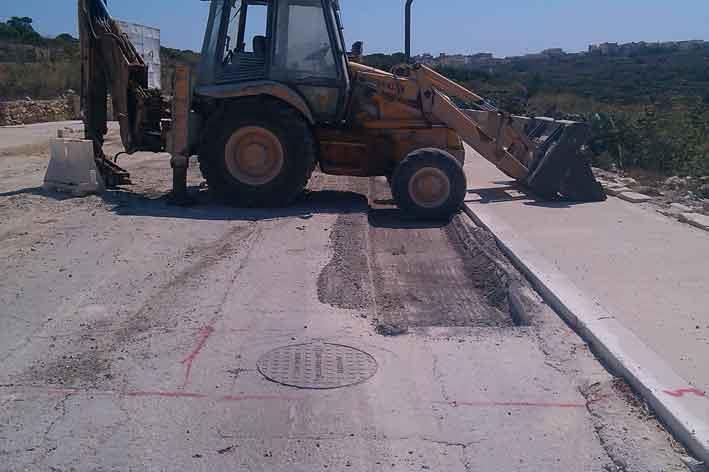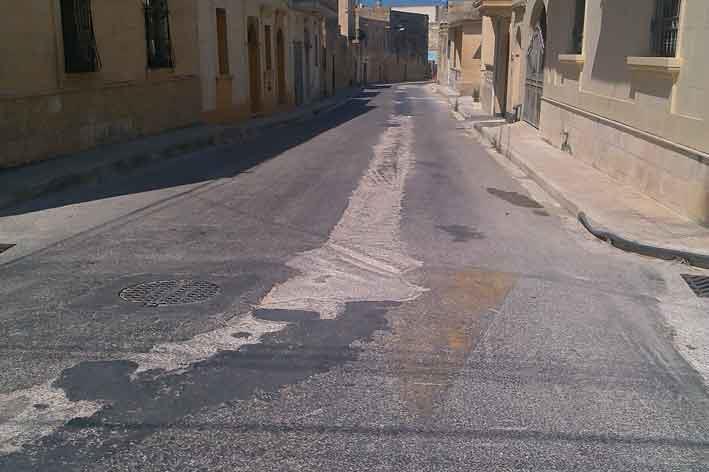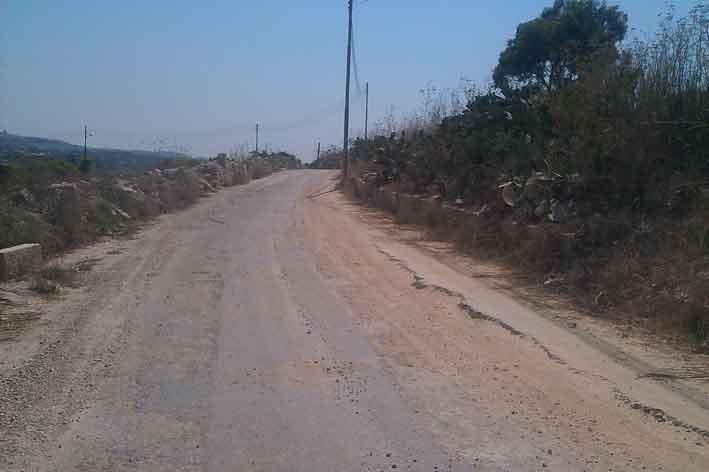Roads in Gozo have been severely disturbed by the laying of water-pipes, starting at Ta Ċenċ and ending near Ħondoq ir-Rummien.
A contract awarded to GTE JV for €4,155,056 was for the laying of a new water pipe, the reinstatement of hot rolled asphalt over areas of the carriageway disturbed as part of the trenching work and also “...the laying of hot rolled asphalt resurfacing along the pipe route over parts of the carriageway not disturbed by trenching work”.
The contract award notice was issued on 1 July 2014 and a Parliamentary Question posed by PN MP Chris Said and answered by Energy Minister Konrad Mizzi read : “The Water Services Corporation had to begin work in July 2014 and finish work by August 2015”. The water main will pass through Qala, Għajnsielem, Xewkija and Sannat.

(On the way to Qala from Ghajnsielem)
The Water Services Corporation, however, said that the project will end ‘in the coming months’, thus indicating that perhaps more time will be needed. “The project will cost just over €4,000,000 and should be completed in the coming months. All road works, (not only trenches surfacing) are covered under this project. The tender was awarded to GTEJV, formed by Gatt Tarmac and Gatt Enterprises, which submitted the cheapest offer. The contractor is bound to finish on time, failing which a penalty may be imposed.”
The tender document read that work was to be completed 385 days after the award of the contract.

(Triq San Andrija, Xewkija)
For the most part, the trenching work seems to have been completed, but the roads themselves are still in a bad state. Indeed, the trench is visible on over 90 per cent of the roads covered, and particularly on the road between Sannat and Għajnsielem, where drivers appear to be bouncing around as if on the back of a horse. In many cases, the trenches have been filled in and roughly surfaced, but the roads have not been tarmacked.
In Sannat, for example, the trench has been filled in and roughly surfaced, but the roads have not been re-tarmacked and are back-breakingly bumpy, not to mention the amount of dust in the air, which is a hazard to everyone, especially those with respiratory disorders such as asthma. When we stopped to ask for directions, one man told us that we needed to be on one road further down from where we were and to turn right: “on to the road that is in a worse state than this one!” It has to be said that some of the roads are in a dreadful state, regardless of the trench.
The road between Xewkija and Sannat, Triq Gruwa, was in a particularly bad condition and an elderly lady said she had no idea when it would be resurfaced.

(Triq Gruwa, Sannat)
Asphalt was being laid on Triq Borġ Għarib in Għajnsielem when this newsroom was on site, but it appeared that trenching work was also still being done.
Trenching work in Qala seems to have been completed, but some of the road surfaces were still quite rough.
Sannat local council has, in fact, written to the Gozo Ministry complaining about the situation, with the Council’s executive secretary describing the state of Triq Dun Luqa as “tal-biza” (frightening).
Xewkija Mayor Paul Azzopardi said he was pleased that all the roads along the pipeline route would be resurfaced, adding that the Council had taken the situation into its own hands and had filled in parts of the trench pending the proper resurfacing

(Ta Cenc Road, Sannat)
Reason for the pipeline
The Water Services Corporation, speaking to this newsroom, said that the Ħondoq-Ta’ Ċenċ pipeline is part of an EU-funded project by the Corporation aimed at reducing its carbon footprint. The work consisted of replacing the previous 9” cast-iron pipes, which were considered too small to meet current demand.
The WSC spokesman explained that water is pumped from the reverse osmosis plant at Ċirkewwa to Ħondoq and then up to the Ta’ Ċenċ reservoirs and energy is needed for this purpose. Due to the small diameter of the original pipes, pumping sufficient quantities of water to meet demand was putting excessive pressure on the water main which meant more energy was being used. Consequently, this process was wasteful due to the amount of energy being consumed.
Recently, another contract has been awarded to Road Construction Co. Ltd for trenching and pipe-laying work between Rabat and Kerċem in Gozo. The offer was for €1,270,642. The contract refers to the fact that the project will be financed by the European Union.